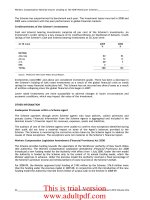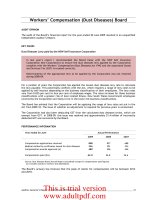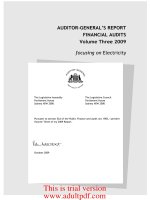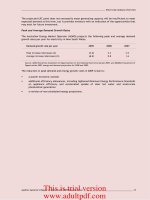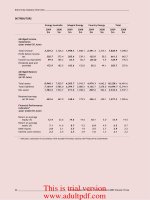New South Wales Auditor-General’s Report Financial Audit Volume Nine 2011 Focusing on Education and Communities_part2 ppt
Bạn đang xem bản rút gọn của tài liệu. Xem và tải ngay bản đầy đủ của tài liệu tại đây (201.8 KB, 11 trang )
10
NSW Auditor
-
General's Report
Volume Nine 2011
CULTURAL OVERVIEW
Commercial Revenue
The New South Wales Government announced $345 million to support the State’s arts and
culture sector in its 2011–12 budget. The major institutions mentioned above will receive
$272 million, which is 15 per cent less than in 2010–11. The government’s 2011–12 budget
requires an annual 1.5 per cent efficiency dividend from these agencies. Management need to
continually identify new efficiencies and/or new ways of increasing income to meet operational
needs and business objectives.
The charging of entry fees to the State’s museums is a vexed issue. While these fees
contribute income that has become essential to our institutions, these fees also discourage
attendance.
The following tables show the level of recurrent government funding and the level of
commercial income over the last five years for these cultural agencies:
The graph above shows recurrent government funding to cultural agencies has remained
fairly stable, but has fallen in real terms after taking into account inflationary increases of
around 15 per cent over the period 2006–07 to 2010–11.
Major exhibitions do provide revenue potential at the major cultural institutions, but these often
require significant upfront fees and investments which are not built into recurrent budgets.
0
10
20
30
40
50
60
70
2007
2008
2009
2010
2011
$m
Year ended 30 June
Government Grants
State Library
Art Gallery Trust
Australian Museum
Powerhouse Museum
Historic Houses Trust
Sydney Opera House
This is trial version
www.adultpdf.com
11
NSW Auditor-
General's Report
Volume Nine 2011
CULTURAL OVERVIEW
The graph above indicates commercial revenue is not increasing to meet the shortfall in the
level of funding. Only the Sydney Opera House has consistently managed to grow its
commercial revenue over the period. The Art Gallery’s revenue was significantly higher in
2010–11 following the successful paid exhibition ‘The First Emperor – China’s Entombed
Warriors’. In 2011, the Australian Museum launched the Jurassic Lounge initiative to attract a
new admission paying audience.
The Sydney Opera House recently engaged Boston Consulting Group to undertake an
efficiency and strategy review to assess options for future operating models to improve
operational and commercial performance. Further details are provided in the Sydney Opera
House comment later in this volume.
Cultural agencies have attempted to maximise revenues from other sources, including
sponsorships, donations and bequests. These are often one-off in nature and cannot be relied
upon as a secure form of operational funding.
In April 2011, the Commonwealth Government commenced a review to identify barriers or
impediments that exist in Australia with respect to private sector support for the arts. The
review will assist with the development and implementation of a national cultural policy.
Further analysis is provided in the individual agencies’ comments later in this volume.
Asset Maintenance
Maintaining cultural, heritage and other buildings represents one of the most significant
funding commitments by cultural agencies. It is their largest item of expenditure other than
employee costs. Heritage buildings in particular have, in many cases, iconic status similar to
some of the collections they accommodate. They need special skills to maintain their historic
aesthetics, but function as modern accommodation. Collection assets also have ongoing
requirements for preservation and restoration.
-
10
20
30
40
50
60
70
2007
2008
2009
2010
2011
$m
Year ended 30 June
Commercial Revenue
State Library
Art Gallery Trust
Australian Museum
Powerhouse Museum
Historic Houses Trust
Sydney Opera House
This is trial version
www.adultpdf.com
12
NSW Auditor
-
General's Report
Volume Nine 2011
CULTURAL OVERVIEW
The table below shows the total amount spent on maintenance by five of these agencies has
grown by 33 per cent over the past five years, an average of 6.6 per cent per annum.
Cultural agencies may also have substantial backlog maintenance, which will need to be
funded by the government. For example, the Art Gallery of New South Wales estimates
backlog maintenance of $22.6 million at 30 June 2011, while the State Library of New South
Wales estimates it at $8.9 million at the same date. The Historic Houses Trust is aware of
about $5.4 million of deferred maintenance at 30 June 2011.
The Sydney Opera House needs $1.1 billion to upgrade its facilities to remain commercially
viable and to address safety concerns. Further details are provided in the Sydney Opera
House comment later in this volume.
Storage of Collections
The storage of growing collections is an ongoing issue for nearly all cultural agencies. Only a
small part of their collections are on display at any given time. The vast majority are
accommodated in storage facilities, some of which are offsite and rented.
In October 2009, I conducted a performance audit on ‘Knowing the Collection’. During the
process, I surveyed the Art Gallery, Australian Museum, Powerhouse Museum and State
Library. All indicated they had insufficient space for current and future collections. Collections
in storage are a significant cost to the bodies, and this is expected to grow.
To ensure the long term sustainability of collections, cultural bodies with large collections
need sound policies, which allow them to determine which collections to preserve into the
future and which to decommission. Many bodies do not currently have plans to manage this
aspect of their operations.
0
5
10
15
20
25
30
35
40
45
2007
2008
2009
2010
2011
2012
$m
Year ended 30 June
Budgeted and Actual Maintenance Expense
Sydney Opera House
Historic Houses Trust
Australian Museum
State Library
Art Gallery Trust
Sector Budgeted Maintenance
This is trial version
www.adultpdf.com
Section Two
Agencies with Individual Comments
Minister for Aboriginal Affairs
Minister for the Arts
Minister for Education
Minister for Family and Community Services
Minister for Heritage
Minister for Planning and Infrastructure
Minister for Primary Industries
Minister for Sport and Recreation
This is trial version
www.adultpdf.com
14
NSW Auditor
-
General's Report
Volume Nine 2011
NEW SOUTH
WALES
ABORIGINAL LAND COUNCIL
Audit Opinion
The audit of the New South Wales Aboriginal Land Council’s financial statements for the year
ended 30 June 2011 resulted in an unmodified audit opinion within the Independent Auditor’s
Report.
Operational Snapshot
The New South Wales Aboriginal Land Council (NSWALC) is the largest member-based
Aboriginal organisation in the State. The Land Council network operates as a two-tiered
structure, with NSWALC as the peak body and 121 Local Aboriginal Land Councils (LALCs).
Both NSWALC and the LALCs are governed by elected boards. NSWALC provides an annual
allocation of funds to LALCs.
The Council aims to protect the interests and further the aspirations of its members and the
broader Aboriginal community. It works for the return of culturally significant and economically
viable land, pursuing cultural, social and economic independence for its people and being
politically proactive and voicing the position of Aboriginal people on issues that affect them.
NSWALC also acts as an advisor to, and negotiates with, governments and other
stakeholders to ensure the preservation of Aboriginal land rights.
It is funded by a Statutory Investment Fund, which was established under the NSW Aboriginal
Land Rights Act 1983 (the Act). The balance of the fund at 30 June 2011 was $550 million
and in 2010–11, NSWALC had expenditure of $35.4 million.
Key Issues
Rural Properties
Recommendation
NSWALC should ensure that Local Aboriginal Land Councils have the capability to operate
rural properties viably before the properties are transferred to councils.
Four rural properties were transferred to NSWALC when Regional Aboriginal Land Councils
were abolished in 1990. They are as follows:
Name of Property
Location Size (ha)
Appin Station
Menindee 31,704
Barooga-Karrai
Euabalong
9,890
Calooma/Nulty Springs
Bourke
35,609
Kaituna-Uno
Coonamble
5,184
Total
82,387
Source: New South Wales Aboriginal Land Council Annual Report 2011.
New South Wales Aboriginal Land
Council
Rural properties
to be transferred
to Local
Aboriginal Land
Councils provided
there is a suitable
business
case
This is trial version
www.adultpdf.com
15
NSW Auditor
-
General's Report
Volume Nine 2011
NEW SOUTH
WALES
ABORIGINAL LAND COUNCIL
The following table shows the combined profitability of these rural properties over the past five
years.
Source: Information provided by NSW Aboriginal Land Council (unaudited).
The rural properties made a profit of $254,000 in 2010–11 (loss of $772,000 in 2009–10). The
profit in 2010–11 was primarily due to the winding down of farming activities which reduced
costs significantly. The rural properties were previously managed by Riverina F.A.R.M.
Services. In September 2010, NSWALC terminated their services and decided to self manage
the properties.
The rural properties incurred substantial losses in past years. In order to mitigate the financial
risks associated with farming activities, in March 2011 NSWALC resolved to dispose of them
to the LALC in the area in which each property is located. Under the terms of the Act, LALCs
are firstly required to prepare a community land and business plan.
It would be appropriate due diligence to ensure that a satisfactory business plan for operating
rural properties is prepared by LALCs and taken into consideration by NSWALC before any
decision is made on the transferring of land. NSWALC was awaiting receipt of the business
plans as at the date of this report.
In the past, a number of LALC’s have been placed under administration and some have been
wound up. When this has occurred, the residual assets and liabilities of LALCs have been
assumed by NSWALC. The decision to transfer rural properties to LALCs, rather than dispose
of them, should only be made based on a strong business case. LALCs are funded by
NSWALC and therefore if the rural properties again incur losses, this will create an exposure
to NSWALC.
-1,000,000
-800,000
-600,000
-400,000
-200,000
0
200,000
400,000
2007
2008
2009
2010
2011
$
Year ended 30 June
Net Income from Rural Properties
Net Loss/Profit
This is trial version
www.adultpdf.com
16
NSW Auditor
-
General's Report
Volume Nine 2011
NEW SOUTH
WALES
ABORIGINAL LAND COUNCIL
Local Aboriginal Land Councils Performance
Recommendation
The Council and the Minister for Aboriginal Affairs should implement agreed actions arising
from the review on sustainability of the NSW Aboriginal Land Rights Network.
During 2010–11, there were four LALCs under administration. Three of these had continued
from the previous reporting period and one new administration was approved by the Minister
for Aboriginal Affairs during the year. Only the minister can place a LALC under
administration.
Last year, I recommended that NSWALC stop funding, and take steps to dissolve,
underperforming LALCs, particularly those under administration. In response to my
recommendation, NSWALC recently circulated a discussion paper on the sustainability of the
Land Council network, which included a number of recommendations for LALCs. In addition,
NSWALC has written to the minister requesting that the Act be amended to clearly define
responsibilities and actions.
The discussion paper included the following recommendations:
x a comprehensive review of funding allocations to LALCs be undertaken, including a new
need-based funding formula which rewards better performing LALCs
x NSWALC dispose of non-performing NSWALC assets to raise funds
x the network makes State Government aware of, and pay for, the costs of any extra
demands it places on the network
x NSWALC encourages the sharing of resources between LALCs and explores a range of
incentives that could be offered
x NSWALC provides incentives for voluntary amalgamations between LALCs
x NSWALC only approves benefit schemes that are supported by professionally prepared
business plans and/or feasibility studies
x NSWALC links benefits to membership such that it encourages eligible people to join their
LALC and become active members.
The Council determined LALCs’ 2010–11 funding based on the audit results of LALCs’
2009-10 financial statements. An analysis of the audit results for the five years from 2006 to
2010 is:
Financial Reporting by LALCs
for y
ear ended 30 June
2010 2009 2008 2007 2006
Satisfactory
109
108
93
91
90
Unsatisfactory
2
5
10
14
7
Not received
8
8
18
16
24
Total
119
121
121
121
121
For the purpose of financial reporting, each LALC is a separate reporting entity. As I have
reported in previous years, some LALCs have failed to comply with the reporting requirements
of the Aboriginal Land Rights Act 1983 (the Act).
The table shows that 8.4 per cent of LALC’s financial reports for 2009–10 (10.7 per cent
in 2008-09) were unsatisfactory or not received, progressively improving over the five year
period from 25.6 per cent in 2005–06 . The eight LALCs for which no financial statements
were received include five LALCs which are not operating.
Discussion has
commenced on
the sustainability
of the Land
Council network
More than 26,000
land claims are
still awaiting
determination
This is trial version
www.adultpdf.com
17
NSW Auditor
-
General's Report
Volume Nine 2011
NEW SOUTH
WALES
ABORIGINAL LAND COUNCIL
Outstanding Land Claims
A total of 35,839 land claims have been lodged since the inception of the Act. Over 9,000
claims have been processed and received determination. More than 26,000 land claims are
still awaiting determination by the New South Wales Government and the courts. The majority
of these were lodged between 2005 and 30 June 2011. Of these, 284 claims were lodged
before 30 June 2000.
The following table shows the claims outstanding for more than 10 years.
Year Claim Lodged
No. of Claims
1984/85
3
1988/89
1
1990/91
1
1993/94
12
1994/95
16
1995/96
98
1996/97
23
1997/98
7
1998/99
13
1999/00
110
Total
284
Source: New South Wales Aboriginal Land Council Annual Report 2011.
Last year in the comment for the Land and Property Management Authority, I recommended
the Authority reduce the time taken to process Aboriginal Land Claims and transfer legal title
to successful claimants. I also recommended that legal title over land granted to successful
Aboriginal land claimants be issued as soon as practicable. This year the functions of the
Authority have been transferred to the Department of Trade and Investment, Regional
Infrastructure and Services as part of the government administrative restructure. I will again
refer to this issue as part of the comment on that department.
There are a substantial number of old unprocessed land claims. NSWALC is working with the
New South Wales Government to reach a resolution on outstanding claims. Land may be
compulsorily acquired by the government under the Land Acquisition (Just Terms
Compensation) Act 1991. Currently, there is no legislative requirement for a LALC or
NSWALC to be notified of a planned compulsory acquisition. Land subject to a claim can be
compulsorily acquired between the lodging of the claim and its final determination by the
court.
Performance Information
Statutory Investment Fund
One of the major challenges to NSWALC’s sustainability continues to be the volatile financial
market which had a significant impact on its equity in recent years. Under Section 150 of the
Act, NSWALC is required to maintain the value of the NSWALC Account (net assets), which
includes the Statutory Investment Fund, above the benchmark of $485 million. The balance of
net assets at 30 June 2011 was $598 million.
NSWALC needs to earn sufficient returns from its investments to meet escalating costs and
maintain its equity for its future sustainability. In order to achieve this it has a Strategic
Investment Policy and has implemented a ‘Spending Rule’ to monitor the escalating cost in
relation to its earnings.
This is trial version
www.adultpdf.com
18
NSW Auditor
-
General's Report
Volume Nine 2011
NEW SOUTH
WALES
ABORIGINAL LAND COUNCIL
The investment portfolio achieved a return of 8.26 per cent in 2010–11 (12.07 per cent).
Following the global financial crisis and associated investment losses, NSWALC revised its
strategic asset allocation in 2010–11. The new allocation increases the share of funds in
overseas equities and Australian inflation linked bonds.
The following chart shows the investment balance and investment returns over the past five
years.
Net investment income or loss comprises interest income, dividend income, realised gains
and losses and fair value gains and losses. The following table shows the composition:
Year Ended 30 June
2011
$’000
2010
$’000
2009
$’000
2008
$’000
2007
$’000
Interest income
1,570
2,474
3,080
3,410
965
Dividend income
13,285
36,101
40,425
43,543
65,767
Realised gains
19,851
8,760
Change in fair value
10,328
16,271
(89,591)
(90,934)
21,349
Total Investment Income/(loss)
45,034
63,606
(46,086)
(43,981)
88,081
When considering the investment performance, it must be noted that NSWALC draws down
on its investments each year to meet operational requirements. In 2010–11, NSWALC drew
down $36.5 million ($37.8 million).
Other Information
Ministerial Review of the Aboriginal Land Rights Act 1983
Under the section 252A of the Act, the minister is required to review the Act at the end of
every five year period to determine whether the policy objectives of the Act remain valid. The
Act was last reviewed in 2006 and is due for review in December 2011.
-100,000
0
100,000
200,000
300,000
400,000
500,000
600,000
700,000
800,000
2007
2008
2009
2010
2011
$
Year ended 30 June
Investment Returns
Closing Balance
Net Income/(Loss)
Direct Draw Down Amount
The NSW
Aboriginal Land
C
ouncil’s
investment
portfolio received
a return of 8.26
per cent in
2010-11
(12.07
per cent in
2009
-10)
This is trial version
www.adultpdf.com
19
NSW Auditor
-
General's Report
Volume Nine 2011
NEW SOUTH
WALES
ABORIGINAL LAND COUNCIL
Purchase of Ordinary Shares in Social Enterprise Finance Australia Limited
(SEFA)
In July 2011, NSWALC purchased $1.0 million of ordinary shares in SEFA. SEFA was
established in May 2011 to provide finance to social enterprises on commercial terms together
with targeted business advice and support. In August 2011, SEFA received seed funding of
$10 million from the Department of Education, Employment and Workplace Relation’s Social
Enterprise Development and Investment Fund. SEFA had capital of $20 million at the date of
this report.
Aboriginal-specific businesses often have real trouble obtaining the necessary financial and
business support to get their enterprises up and running. It is anticipated that NSWALC’s
investment in SEFA will contribute to a sustainable economic base for Aboriginal
communities.
Walgett and Subdivision Program
The Walgett program delivered repairs and maintenance to 70 houses owned by the Walgett
Local Aboriginal Land Council. The program was funded by the Australian Government and
was completed in 2010-11.
The Subdivision program is a jointly funded project with the Australian Government for the
surveying and subdivision of former Aboriginal reserves in New South Wales.
The following table summarises the current status of the programs funding:
Walgett Subdivision
Total
grant received at 30 June $4,830,000 $3,000,000
Total amount spent at 30 June
$4,853,530
$355,728
Starting date
26 June 2008
26 June 2008
Expected completion date
30 June 2012
30 June 2014
Water and sewerage services
In partnership with the New South Wales Government, NSWALC maintained its commitment
to deliver better water and sewerage services to Aboriginal communities across the State.
Together they will invest more than $200 million over the next 25 years to improve these
services. The roll out of the program began in 2008–09 and the following table shows capital
expenditure over the last three years:
Year ended 30 June
2011 2010 2009
Capital Expenditure
$1,732,765
$1,002,000
$243,118
Endowment Fund
In 2007–08, NSWALC established a $30.0 million Education Endowment Fund (the Fund),
which aims to provide ongoing support for Aboriginal people’s studies. Scholarships are
available for primary schools, secondary schools, universities, vocational and TAFE courses.
The intention is that the interest earned on the fund, which is invested, will be sufficient to
cover the cost of the scholarship program.
This is trial version
www.adultpdf.com
20
NSW Auditor
-
General's Report
Volume Nine 2011
NEW SOUTH
WALES
ABORIGINAL LAND COUNCIL
The fund is administered by Charities Aid Foundation (CAF). CAF is responsible for the
application process, all associated due diligence and legal compliance. Scholarship payments
for the years 2008–11 are presented in the following table:
Year ended 30 June
2011 2010 2009 2008
No. of
applications received
2,205
441
256
201
No. of applications approved
1,141
312
124
119
Total Payments ($)
1,334,000
182,000
1,201,000
The demand for scholarships increased substantially in 2010-11. As demand exceeded the
budget, all approved applications were funded at a reduced individual amount.
Grants Paid
In addition to the annual allocation of funds to LALCs, NSWALC provided major grants of
$1.4 million ($207,665) and minor grants of $788,893 ($736,830) to community organisations
and individuals. The grants are listed below:
Major Grants (more than $5,000)
Payee
Purpose
Year ended
30 June 2011
$
Year ended
30 June 2010
$
University of Newcastle
Education Scholarship Grant
58,050
31,365
Riverina Crane Services Pty Ltd
Grant for Wagga Wagga LALC to
help comply with Environment
Planning and Assessment Act
1979
19,950
Arts Mid North Coast
Sponsorship for Dinner with Elders
10,000
CAF AUSTRALIA
Education Scholarship Grant
1,276,320
101,000
Presbyterian Ladies College
Education Scholarship Grant
5,350
Tamworth Local Aboriginal Land
Council
Funding for Northern Regional
Partnership Agreement Negotiation
50,000
Australian Indigenous
Leadership Centre
Education Scholarship Grant
40,000
Tribal Warrior Association
Incorporated
Funding for the Chicka Story Book
13,636
Gadigal Information Services
Aboriginal Corporation
Sponsorship for the Yabun Festival
2011
10,000
Saltwater Freshwater Arts
Alliance
Saltwater Freshwater Festival
Sponsorship
10,000
NSW Aboriginal Golf
Incorporated
Sponsorship for NSW Aboriginal
Golf Championships
10,000
Total Major Grants
1,428,006
207,665
Minor Grants ($5,000 or less)
Year ended 30 June
Category
2011
Number
2011
$
2010
Number
2010
$
Discretionary
47
56,037
2
6,000
Funeral
432
732,856
444
726,980
Total
479
788,893
447
732,980
This is trial version
www.adultpdf.com



